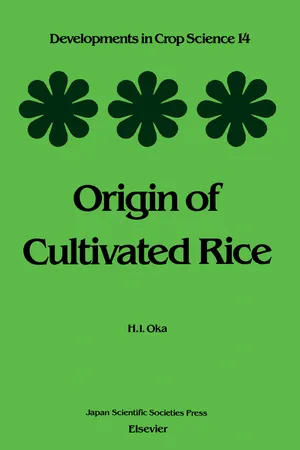Origin of Cultivated Rice
About This Book
This book aims to up-date our present understanding of the origin of cultivated rice and in doing so involves different disciplines of biology and the archaeological-historical sciences. Various recent discoveries are reviewed and questions posed for further consideration by the reader.The book covers a wide range of studies on problems relative to the origin of cultivated rice, placing emphasis on ecological and genetical aspects. Comparisons are made between two cultivated rice species, independently evolved in Asia and Africa from respective wild progenitors. Phenomena are observed during mixed planting and hybrids discussed. Detailed information is presented about Asian common wild rice, thought to be the ancestor of common rice. The dynamics of domestication are considered with regard to hybridization, selection, formation of weedy types and the accumulation of genetic diversity. Also included are recent archaeological findings in relation to the beginnings of rice culture, leading to the hypothesis of diffused origins. Cultivars of common rice fall into one of two types called Indica and Japonica. The dynamics of differentiation are discussed, giving evidence and different hypotheses. Information on the genetic bases and functions of various reproductive barriers found between the cultivated and wild taxa is presented and discussed. The practical aspects of crop-evolutionary studies concerned with the breeding phylosophy and germplasm conservation are briefly commented on and arguments for rediversification of crop germplasm and conservation of the environment given.Senior scientists and post-graduate students interested in rice genetics, crop evolution, and related sciences will find this book invaluable.
Frequently asked questions
Information
Table of contents
- Front Cover
- Origin of Cultivated Rice
- Copyright Page
- Table of Contents
- Preface
- Synopsis
- Chapter 1. The Genus Oryza
- Chapter 2. The Ancestors of Cultivated Rice
- Chapter 3. Ecology and Population Biology of the Common Wild Rice
- Chapter 4. Genetic Variations and Evolutionary Dynamics
- Chapter 5. The Dynamics of Domestication
- Chapter 6. The Homeland of Oryza sativa
- Chapter 7. Indica-Japonica Differentiation of Rice Cultivars
- Chapter 8. Functions and Genetic Bases of Reproductive Barriers
- Chapter 9. Variations in Adaptability to Environment
- Chapter 10. Germplasm Conservation
- REFERENCES
- SUBJECT INDEX
